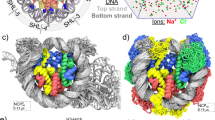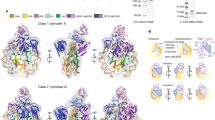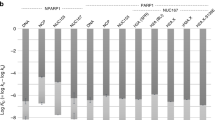Abstract
DNA wrapped in nucleosomes is sterically occluded, creating obstacles for polymerase, regulatory, remodeling, repair and recombination complexes, which require access to the wrapped DNA. How such complexes recognize and gain access to their DNA target sites is not known. Here we report the direct detection of a dynamic equilibrium conformational transition in nucleosomes that greatly increases the distance between the end of the nucleosomal DNA and the histone core. We quantified the equilibrium constant for this transition under physiological conditions. As predicted by these findings, addition of LexA protein to nucleosomes containing the LexA target site drives this conformational equilibrium toward the unwrapped, accessible state, simultaneously allowing stable LexA binding. This inherent property of nucleosomes allows any protein, whether an energy-dependent machine or a passive binder, to gain access even to buried stretches of nucleosomal DNA.
This is a preview of subscription content, access via your institution
Access options
Subscribe to this journal
Receive 12 print issues and online access
$189.00 per year
only $15.75 per issue
Buy this article
- Purchase on Springer Link
- Instant access to full article PDF
Prices may be subject to local taxes which are calculated during checkout





Similar content being viewed by others
References
Richmond, T.J. & Davey, C.A. The structure of DNA in the nucleosome core. Nature 423, 145–150 (2003).
Fragoso, G., John, S., Roberts, M.S. & Hager, G.L. Nucleosome positioning on the MMTV LTR results from the frequency-biased occupancy of multiple frames. Genes Dev. 9, 1933–1947 (1995).
Felsenfeld, G. Chromatin unfolds. Cell 86, 13–19 (1996).
Kornberg, R.D. & Lorch, Y. Chromatin-modifying and -remodeling complexes. Curr. Opin. Genet. Dev. 9, 148–151 (1999).
Ahmad, K. & Henikoff, S. Epigenetic consequences of nucleosome dynamics. Cell 111, 281–284 (2002).
Felsenfeld, G. & Groudine, M. Controlling the double helix. Nature 421, 448–453 (2003).
Kornberg, R.D. & Lorch, Y. Twenty-five years of the nucleosome, fundamental particle of the eukaryote chromosome. Cell 98, 285–294 (1999).
Narlikar, G.J., Fan, H.Y. & Kingston, R.E. Cooperation between complexes that regulate chromatin structure and transcription. Cell 108, 475–487 (2002).
Fan, H.-Y., He, X., Kingston, R.E. & Narlikar, G.J. Distinct strategies to make nucleosomal DNA accessible. Mol. Cell 11, 1311–1322 (2003).
Kassabov, S.R., Zhang, B., Persinger, J. & Bartholomew, B. SWI/SNF unwraps, slides, and rewraps the nucleosome. Mol. Cell 11, 391–403 (2003).
Längst, G. & Becker, P.B. ISWI induces nucleosome sliding on nicked DNA. Mol. Cell 8, 1085–1092 (2001).
Polach, K.J. & Widom, J. Mechanism of protein access to specific DNA sequences in chromatin: a dynamic equilibrium model for gene regulation. J. Mol. Biol. 254, 130–149 (1995).
Polach, K.J. & Widom, J. A model for the cooperative binding of eukaryotic regulatory proteins to nucleosomal target sites. J. Mol. Biol. 258, 800–812 (1996).
Felsenfeld, G. Quantitative approaches to problems of eukaryotic gene expression. Biophys. Chem. 100, 607–613 (2003).
Miller, J.A. & Widom, J. Collaborative competition mechanism for gene activation in vivo. Mol. Cell. Biol. 23, 1623–1632 (2003).
Lorch, Y., LaPointe, J.W. & Kornberg, R.D. Nucleosomes inhibit the initiation of transcription but allow chain elongation with the displacement of histones. Cell 49, 203–210 (1987).
Taylor, I.C.A., Workman, J.L., Schuetz, T.J. & Kingston, R.E. Facilitated binding of GAL4 and heat shock factor to nucleosomal templates: differential function of DNA-binding domains. Genes Dev. 5, 1285–1298 (1991).
Vettese-Dadey, M., Walter, P., Chen, H., Juan, L.-J. & Workman, J.L. Role of the histone amino termini in facilitated binding of a transcription factor, GAL4-AH, to nucleosome cores. Mol. Cell. Biol. 14, 970–981 (1994).
Owen-Hughes, T. & Workman, J.L. Remodeling the chromatin structure of a nucleosome array by transcription factor-targeted trans-displacement of histones. EMBO J. 15, 4702–4712 (1996).
Owen-Hughes, T., Utley, R.T., Cote, J., Peterson, C.L. & Workman, J.L. Persistent site-specific remodeling of a nucleosome array by transient action of the SWI/SNF complex. Science 273, 513–516 (1996).
Ura, K., Hayes, J.J. & Wolffe, A.P. A positive role for nucleosome mobility in the transcriptional activity of chromatin templates: restriction by linker histones. EMBO J. 14, 3752–3765 (1995).
Meersseman, G., Pennings, S. & Bradbury, E.M. Mobile nucleosomes—a general behavior. EMBO J. 11, 2951–2959 (1992).
Anderson, J.D., Thåström, A. & Widom, J. Spontaneous access of proteins to buried nucleosomal DNA target sites occurs via a mechanism that is distinct from nucleosome translocation. Mol. Cell. Biol. 22, 7147–7157 (2002).
Richmond, T.J. & Widom, J. Nucleosome and chromatin structure. In Chromatin Structure and Gene Expression: Frontiers in Molecular Biology 2/e (eds. Elgin, S. & Workman, J.L.) (Oxford Univ. Press, Oxford, 2000).
Whitehouse, I., Flaus, A., Havas, K. & Owen-Hughes, T. Mechanisms for ATP-dependent chromatin remodelling. Biochem. Soc. Trans. 28, 376–379 (2000).
Varga-Weisz, P.D. & Becker, P.B. Chromatin-remodeling factors: machines that regulate? Curr. Biol. 10, 346–353 (1998).
Clegg, R.M. Fluorescence resonance energy transfer and nucleic acids. Methods Enzymol. 211, 353–388 (1992).
Ha, T. et al. Initiation and re-initiation of DNA unwinding by the Escherichia coli Rep helicase. Nature 419, 638–641 (2002).
van Holde, K.E. Chromatin (Springer, New York, 1989).
Manning, G.S. The molecular theory of polyelectrolyte solutions with applications to the electrostatic properties of polynucleotides. Q. Rev. Biophys. 11, 179–246 (1978).
Polach, K.J. & Widom, J. Restriction enzymes as probes of nucleosome stability. Methods Enzymol. 304, 278–298 (1999).
Anderson, J.D. & Widom, J. Sequence- and position-dependence of the equilibrium accessibility of nucleosomal DNA target sites. J. Mol. Biol. 296, 979–987 (2000).
Feynman, R.P., Leighton, R.B. & Sands, M. The Feynman Lectures on Physics (Addison-Wesley, Reading, Massachusetts, USA, 1963).
Peterson, C.L. & Logie, C. Recruitment of chromatin remodeling machines. J. Cell. Biochem. 78, 179–185 (2000).
Lowary, P.T. & Widom, J. New DNA sequence rules for high affinity binding to histone octamer and sequence-directed nucleosome positioning. J. Mol. Biol. 276, 19–42 (1998).
Dorigo, B., Schalch, T., Bystricky, K. & Richmond, T.J. Chromatin fiber folding: requirement for the histone H4 N-terminal tail. J. Mol. Biol. 327, 85–96 (2003).
Luger, K., Rechsteiner, T.J. & Richmond, T.J. Preparation of nucleosome core particle from recombinant histones. Methods Enzymol. 304, 3–19 (1999).
Little, J.W. et al. Cleavage of LexA repressor. Methods Enzymol. 244, 266–284 (1994).
Thåström, A., Bingham, L.M. & Widom, J. Nucleosomal locations of dominant DNA sequence motifs for histone-DNA interactions and nucleosome positioning. J. Mol. Biol. 338, 695–709 (2004).
Acknowledgements
We thank T. Richmond and J. Hayes for X. laevis histone expression plasmids and J. Little for the LexA expression plasmid. We acknowledge the use of instruments in the Keck Biophysics Facility at Northwestern University. This work was supported by grants from the US National Institutes of Health to J.W.
Author information
Authors and Affiliations
Corresponding author
Ethics declarations
Competing interests
The authors declare no competing financial interests.
Supplementary information
Supplementary Fig. 1
[Mg2+] negligibly affects DNA unwrapping in physiological [NaCl]. (PDF 52 kb)
Rights and permissions
About this article
Cite this article
Li, G., Widom, J. Nucleosomes facilitate their own invasion. Nat Struct Mol Biol 11, 763–769 (2004). https://doi.org/10.1038/nsmb801
Received:
Accepted:
Published:
Issue Date:
DOI: https://doi.org/10.1038/nsmb801
This article is cited by
-
Lola-I is a promoter pioneer factor that establishes de novo Pol II pausing during development
Nature Communications (2023)
-
Structural basis for APE1 processing DNA damage in the nucleosome
Nature Communications (2022)
-
Generating specificity in genome regulation through transcription factor sensitivity to chromatin
Nature Reviews Genetics (2022)
-
Sox2 levels regulate the chromatin occupancy of WNT mediators in epiblast progenitors responsible for vertebrate body formation
Nature Cell Biology (2022)
-
Nucleosome plasticity is a critical element of chromatin liquid–liquid phase separation and multivalent nucleosome interactions
Nature Communications (2021)



